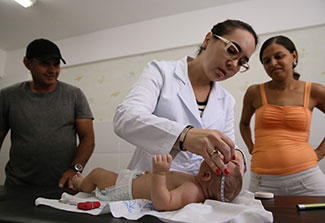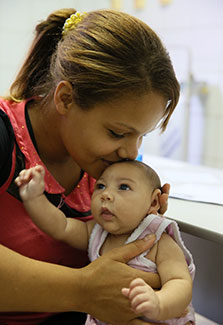Chagas disease studies inform Zika research in Brazil
November / December 2016 | Volume 15, Number 6

Photo by Harold Ruiz/PAHO-WHO
A doctor in Brazil measures the circumference of the head of
a baby whose mother was infected with the Zika virus during
pregnancy.
For more than 100 years before it was hit by the Zika virus, Brazil was battling Chagas disease, a vector-borne illness that is usually asymptomatic in the acute stage, but has deadly or debilitating health impacts long after infection - not unlike Zika. Funding for Chagas research from the National Institute of Neurological Disorders and Stroke (NINDS), through Fogarty's Global Brain Disorders Research program, has allowed Brazil to make strides against the disease by training scientists in field epidemiology, neuroimaging techniques and other research skills. So when, in 2015, doctors raised the alarm about the devastating impacts of the Zika virus on infants' brains, Brazilian researchers were able to adapt the models they'd been applying to Chagas research and apply them to help understand Zika.
"One project leads to another, everything is intertwined," said Dr. Jamary Oliveira-Filho of the Federal University of Bahia, one of the lead researchers on NIH-supported clinical trials and studies investigating the links between Chagas and stroke. "We're using similar tools to investigate brain involvement in Chagas and children suffering from microcephaly caused by the Zika virus."
Chagas and Zika share many common characteristics, including that they both cause inflammation, which can result in brain atrophy, said Oliveira. In Zika, this manifests as microcephaly in infants, and in Chagas, it occurs over decades in adults. Most infants are infected with Zika in utero, often after their mother is bitten by a mosquito with the virus. Chagas is caused by a parasite that is carried by mosquitoes and other insects. But because the illness is mild in the acute stages, those infected are often unaware that they have Chagas and do not seek treatment or diagnosis. Twenty to 30 years later, around a third of infected patients develop cardiomyopathy, the most common manifestation of Chagas in humans. Lesser numbers develop intestinal disease or a neurological disorder.

Photo by Harold Ruiz/PAHO-WHO
A mother in Brazil kisses her baby. Zika
and Chagas both cause brain atrophy,
which, in Zika, manifests as microcephaly
in infants.
Brain involvement in Chagas was long believed to be related to the illness' signature condition, cardiac disease. But Oliveira began looking for other explanations for Chagas-associated neurological disorders when he noticed that a considerable proportion of patients who have the disease without cardiac involvement still have a history of stroke. "In our cohort, it was 15 percent of patients - not insignificant," noted Oliveira, who observed in his research that some Chagas patients develop cognitive impairment and brain atrophy, but do not have a stroke.
Oliveira and his team in Brazil, working with researchers at Harvard and Brown Universities in the U.S., have shown in NIH-funded studies that stroke occurs in Chagas patients independently of cardiomyopathy - an important finding because a Chagas serologic test is usually only ordered for stroke patients who are from endemic areas and have evidence of cardiac disease. They are continuing their studies to see if Chagas is an independent risk factor for cognitive impairment, and whether aspirin provides primary protection against stroke in high-risk Chagas patients.
Oliveira is also trying to identify a biomarker for Chagas-associated cardiomyopathy, which would allow children to be tested for the illness. "Chagas can be treated successfully in the early phase, but there is no treatment in the chronic phase," he said. "If we can identify a biomarker for Chagas inflammation that we can block or change, we could decrease or eliminate the chances that people who get Chagas as children will have strokes, heart disease or intestinal problems later in life, and the financial and moral burdens that come with caring for someone with a long-term illness."
Around 8 million people worldwide have Chagas disease, mostly in Latin America, and 11,000 people die of the disease each year, according to the WHO.
More Information
Updated January 19, 2017
To view Adobe PDF files,
download current, free accessible plug-ins from Adobe's website.